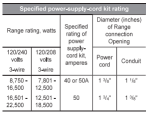Bought a new LG electric range (home depot link here). Product manual here.
Confused on what size breaker, what gauge NM-b wire, and appliance cord rating to use.
Manual does not state breaker size.
![Image]()
**Manual lists it as 12.9 kW.
![Image]()
**Manual states 40 amp minimum cord, 3 wire can use 40A or 50A cord, but 4 wire cord must be 50A rated?
NEC Table 220.55 Demand Factors and Loads for Household Electric Range, .... states that 1 appliance has a max demand of 8 kW, up to 12 kW rated appliances. Add 5% rating to each additional kW above 12 kW. In my case, that would mean max demand load of 8 kW * 1.05 = 8.4 kW.
So stove manual lists 12.9 kW, which 12.9 kW / 240v = 53.75 amps.
Manual has minimum 40 amp appliance cord, 40A or 50A can be used in 3-wire chart, but 4-wire text says 50 amp only.
NEC indicates max demand load would be 8.4 kW. 8.4 kW / 240v = 35 amps.
This all seems contradictory. Based on 12.9 kW rating, you would need 60 amp breaker, 6/3 or 4/3 NM-b, and 60 amp range cord (this even exist in residential)?
Per the NEC max demand load, I could run a 40 amp breaker, 8/3 NM-b, and 4 amp range cord.
Big difference
What size breaker?
What gauge NM-b
What size appliance cord should be used?
My plan right now is 50 amp breaker, 6/3 NM-b, and 50 amp appliance cord, but trying to understand the above numbers.
Confused on what size breaker, what gauge NM-b wire, and appliance cord rating to use.
Manual does not state breaker size.
**Manual states 40 amp minimum cord, 3 wire can use 40A or 50A cord, but 4 wire cord must be 50A rated?
NEC Table 220.55 Demand Factors and Loads for Household Electric Range, .... states that 1 appliance has a max demand of 8 kW, up to 12 kW rated appliances. Add 5% rating to each additional kW above 12 kW. In my case, that would mean max demand load of 8 kW * 1.05 = 8.4 kW.
So stove manual lists 12.9 kW, which 12.9 kW / 240v = 53.75 amps.
Manual has minimum 40 amp appliance cord, 40A or 50A can be used in 3-wire chart, but 4-wire text says 50 amp only.
NEC indicates max demand load would be 8.4 kW. 8.4 kW / 240v = 35 amps.
This all seems contradictory. Based on 12.9 kW rating, you would need 60 amp breaker, 6/3 or 4/3 NM-b, and 60 amp range cord (this even exist in residential)?
Per the NEC max demand load, I could run a 40 amp breaker, 8/3 NM-b, and 4 amp range cord.
Big difference
What size breaker?
What gauge NM-b
What size appliance cord should be used?
My plan right now is 50 amp breaker, 6/3 NM-b, and 50 amp appliance cord, but trying to understand the above numbers.






